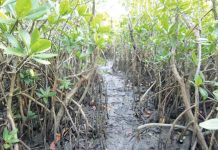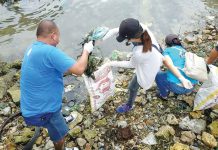
ADDITIONAL seagrass species in the island of Boracay was recently recorded.
A team of professionals from the Dagatnon Environmental Consulting Services who were tapped by Conservation Development Division (CDD) of the DENR 6 conducted the seagrass mapping and assessment in the island on January 29, 2020. The team has identified nine species of seagrass including the newly, recorded species called Halophila spinulosa.
Halophila spinulosa has tiny leaves that grow in opposite pairs on a long thin stem forming a flat fern-like overall shape. Around 10-20 pairs may form on the stem. New leaves grow from the tip while older leaves at the bottom drop off. A leaf is about two centimeters long and 0.4 centimeters wide with tiny serrations on the edges and a small one-sided fold at the base.
Seagrasses are angiosperm or flowering plant that holds a vital role to the complex coastal ecosystem, as being one of the most productive coastal habitats. The leaves harbor epiphytic algae and animals like sea squirts that serve as food sources to larger animals such as fish, sea turtles, crabs, lobsters, sea cows or dugong and sea birds. Its foliage also slows down water currents and traps sediments that clear and improves nearshore waters.
There are 16 species of seagrass found in the Philippines and nine of them are recorded existing in the island of Boracay including the newly recorded species Halophila spinulosa or the fern seagrass that was recently recorded by Jan Felix Balquin of the Dagatnon. Balquin was able to photographed Halophila spinulosa situated in not more than 1×1 meter portion of the seagrass bed.
Boracay Island has approximately 95.37 hectares of seagrass bed. The Barangay Balabag in the island yield the highest percentage cover with 81.84 percent followed by Barangay Manocmanoc and Yapak with 53.85 percent and 53.68 percent respectively according to the report on Assessment, Mapping, and Delineation of Coastal and Marine Resources and Marine Protected Areas in Boracay Island, Malay, Aklan which is subjected for regional review.
The seagrass mapping and assessment was conducted in connection to the Coastal and Marine Ecosystem Management Program (CMEMP) that aims to manage, address and effectively reduce threats of degradation on coastal and marine ecosystem for the sustainability of ecosystem services, food security and climate change resiliency. CMEMP’s thrust also include assessment and mapping the extent of the areas covered by different coastal habitat as well as identifying, characterizing and analyzing the threats that affect the island.
In 2018, the Department of Environment and Natural Resources (DENR) considered the successful rehabilitation of Boracay Island as the “single biggest accomplishment” along with other government offices as they rendered adequate amount of time, effort and resources to fulfil the President’s directive.
“The cleaner waters of Boracay Island due to the continuous rehabilitation have helped sustain the healthy marine ecosystem. We eventually conducted the initiative on biodiversity monitoring that resulted to the discovery of species of marine resources in the island. Let us continue to exert efforts in conserving the infamous white sand beach that Boracay offers,” said regional executive director Francisco E. Milla, Jr.
Enhanced biodiversity conservation and scaling up of coastal and marine ecosystem program are among the top ten priority programs of Environment Secretary Roy A. Cimatu./PN







